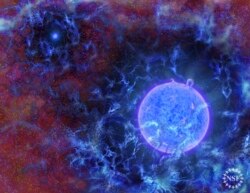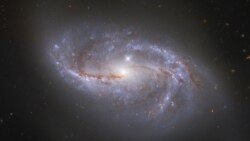Scientists have released the largest three-dimensional, or 3D map of the universe ever created.
The map is the result of a project launched more than 20 years ago by an international group of astrophysicists. The project aimed to map the universe using data collected from a telescope in the southwestern U.S. state of New Mexico.
The effort used observations from the Sloan Digital Sky Survey, one of the largest astronomical surveys ever carried out. The project received major funding from the U.S.-based Alfred P. Sloan Foundation, a non-profit science research organization.
Researchers say the new 3D map produced measurements of more than two million galaxies and quasars. The scientists defined quasars as “bright galaxies lit up by material falling onto a central supermassive black hole.”
The measurements helped the team produce a "complete story of the expansion of the universe," lead researcher Will Percival said in a statement. Percival is a professor of physics and astronomy at the University of Waterloo in Ontario, Canada.
Especially, Percival said the 3D map had “filled in 11 billion years in our picture of the universe.”
Another leader of the research team was Kyle Dawson, a physics and astronomy professor at the University of Utah. He explained that the 3D map is finally providing scientists with information about a large hole in the history of the universe.
“We know both the ancient history of the universe and its recent expansion history fairly well, but there’s a troublesome gap in the middle 11 billion years,” Dawson said in a statement.
The latest research has helped fill in that information gap, producing some of the most “substantial advances” in the study of the universe of the past 10 years, he added.
The early history of the universe is much more understood because of years of theoretical models and observations of electromagnetic radiation. Studies of galaxies and distance measurements also helped scientists better understand much of the universe's expansion over billions of years.
Astrophysicist Jean-Paul Kneib of the Swiss Federal Institute of Technology in Lausanne helped launch the mapping project. He said in a statement the goal was to produce "the most complete 3D map of the universe throughout the lifetime of the universe."
The map shows the elements making up the structure of the universe, “starting from the time when the universe was only about 300,000 years old.” It permits researchers to measure patterns in how galaxies are positioned.
Dustin Lang is a researcher on the project from Canada’s Perimeter Institute research center. He said the new 3D map can greatly improve efforts to study individual stars, galaxies and the universe as a whole. “It really is incredible that one experiment has produced such a scientific legacy.”
The map suggests that the expansion of the universe began to speed up at some point and has continued to do so. The researchers said this seems to be caused by the presence of dark energy. Scientists believe this unseen element fits into Albert Einstein's general theory of relativity. The theory of relativity relates to the laws of gravity and describes the movement of large objects.
Comparisons between the latest observations and past studies of the early universe have shown differences in the estimated rates of expansion. The currently accepted rate, called the "Hubble constant," is 10 percent slower than the value resulting from distances between galaxies closest to Earth.
I’m Bryan Lynn.
Bryan Lynn wrote this story for VOA Learning English, based on reports from Agence France-Presse, the University of Waterloo and the Sloan Digital Sky Survey. Hai Do was the editor.
We want to hear from you. Write to us in the Comments section, and visit our Facebook page.
________________________________________________________________
Words in This Story
three-dimensional – adj. appearing to have length, depth and width
survey – n. an examination of an area in which its measurements and details are recorded, especially for the purpose of creating a map
galaxy – n. a large group of stars from the same universe
gap – n. an empty hole or space in the middle of something
substantial – adj. large in amount
advance – n. new discoveries and inventions
pattern – n. the way something is often done or repeated
legacy – n. something that is left for people in the future










